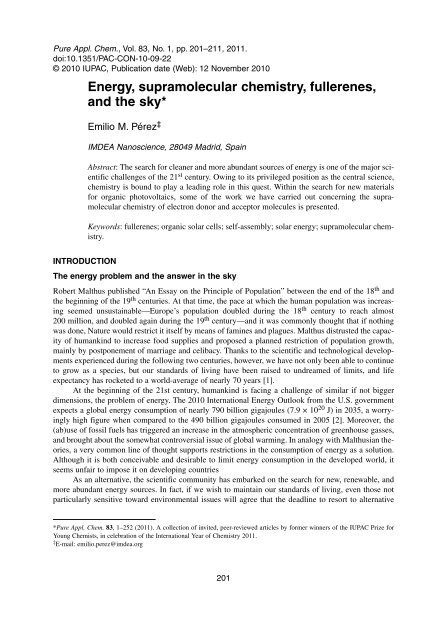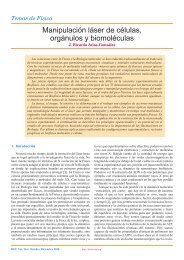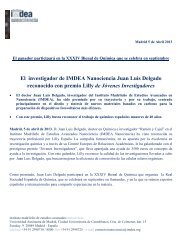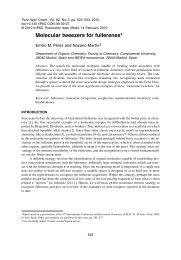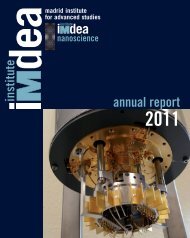Energy, supramolecular chemistry, fullerenes, and the sky* - IMDEA ...
Energy, supramolecular chemistry, fullerenes, and the sky* - IMDEA ...
Energy, supramolecular chemistry, fullerenes, and the sky* - IMDEA ...
- No tags were found...
Create successful ePaper yourself
Turn your PDF publications into a flip-book with our unique Google optimized e-Paper software.
Pure Appl. Chem., Vol. 83, No. 1, pp. 201–211, 2011.doi:10.1351/PAC-CON-10-09-22© 2010 IUPAC, Publication date (Web): 12 November 2010<strong>Energy</strong>, <strong>supramolecular</strong> <strong>chemistry</strong>, <strong>fullerenes</strong>,<strong>and</strong> <strong>the</strong> <strong>sky*</strong>Emilio M. Pérez ‡<strong>IMDEA</strong> Nanoscience, 28049 Madrid, SpainAbstract: The search for cleaner <strong>and</strong> more abundant sources of energy is one of <strong>the</strong> major scientificchallenges of <strong>the</strong> 21 st century. Owing to its privileged position as <strong>the</strong> central science,<strong>chemistry</strong> is bound to play a leading role in this quest. Within <strong>the</strong> search for new materialsfor organic photovoltaics, some of <strong>the</strong> work we have carried out concerning <strong>the</strong> supra -molecular <strong>chemistry</strong> of electron donor <strong>and</strong> acceptor molecules is presented.Keywords: <strong>fullerenes</strong>; organic solar cells; self-assembly; solar energy; <strong>supramolecular</strong> <strong>chemistry</strong>.INTRODUCTIONThe energy problem <strong>and</strong> <strong>the</strong> answer in <strong>the</strong> skyRobert Malthus published “An Essay on <strong>the</strong> Principle of Population” between <strong>the</strong> end of <strong>the</strong> 18 th <strong>and</strong><strong>the</strong> beginning of <strong>the</strong> 19 th centuries. At that time, <strong>the</strong> pace at which <strong>the</strong> human population was increasingseemed unsustainable—Europe’s population doubled during <strong>the</strong> 18 th century to reach almost200 million, <strong>and</strong> doubled again during <strong>the</strong> 19 th century—<strong>and</strong> it was commonly thought that if nothingwas done, Nature would restrict it itself by means of famines <strong>and</strong> plagues. Malthus distrusted <strong>the</strong> capacityof humankind to increase food supplies <strong>and</strong> proposed a planned restriction of population growth,mainly by postponement of marriage <strong>and</strong> celibacy. Thanks to <strong>the</strong> scientific <strong>and</strong> technological developmentsexperienced during <strong>the</strong> following two centuries, however, we have not only been able to continueto grow as a species, but our st<strong>and</strong>ards of living have been raised to undreamed of limits, <strong>and</strong> lifeexpectancy has rocketed to a world-average of nearly 70 years [1].At <strong>the</strong> beginning of <strong>the</strong> 21st century, humankind is facing a challenge of similar if not biggerdimensions, <strong>the</strong> problem of energy. The 2010 International <strong>Energy</strong> Outlook from <strong>the</strong> U.S. governmentexpects a global energy consumption of nearly 790 billion gigajoules (7.9 × 10 20 J) in 2035, a worryinglyhigh figure when compared to <strong>the</strong> 490 billion gigajoules consumed in 2005 [2]. Moreover, <strong>the</strong>(ab)use of fossil fuels has triggered an increase in <strong>the</strong> atmospheric concentration of greenhouse gasses,<strong>and</strong> brought about <strong>the</strong> somewhat controversial issue of global warming. In analogy with Malthusian <strong>the</strong>ories,a very common line of thought supports restrictions in <strong>the</strong> consumption of energy as a solution.Although it is both conceivable <strong>and</strong> desirable to limit energy consumption in <strong>the</strong> developed world, itseems unfair to impose it on developing countriesAs an alternative, <strong>the</strong> scientific community has embarked on <strong>the</strong> search for new, renewable, <strong>and</strong>more abundant energy sources. In fact, if we wish to maintain our st<strong>and</strong>ards of living, even those notparticularly sensitive toward environmental issues will agree that <strong>the</strong> deadline to resort to alternative*Pure Appl. Chem. 83, 1–252 (2011). A collection of invited, peer-reviewed articles by former winners of <strong>the</strong> IUPAC Prize forYoung Chemists, in celebration of <strong>the</strong> International Year of Chemistry 2011.‡ E-mail: emilio.perez@imdea.org201
<strong>Energy</strong>, <strong>chemistry</strong>, <strong>fullerenes</strong>, <strong>and</strong> organic solar cells 203important implications when it comes to <strong>the</strong> possible noncovalent interactions that we can utilize toassociate <strong>fullerenes</strong> in solution. The impossibility of utilizing strong directional forces, like metal–lig<strong>and</strong>coordination or hydrogen bonding, to recognize <strong>fullerenes</strong>, leaves us with π–π, van der Waals, <strong>and</strong>solvophobic interactions as key factors to consider. Fortunately, optimizing all of <strong>the</strong>m requires <strong>the</strong>same strategy: increasing <strong>the</strong> surface of <strong>the</strong> receptor in short contact with <strong>the</strong> fullerene guest. Thus, <strong>the</strong>nuts <strong>and</strong> bolts of <strong>the</strong> design of hosts for <strong>fullerenes</strong> is <strong>the</strong> construction of a nonpolar cavity—preferentiallybut not necessarily featuring aromatic recognizing units—of <strong>the</strong> appropriate size to fit <strong>the</strong>fullerene guest.The search for molecules capable of associating <strong>fullerenes</strong> in solution was initiated just sevenyears after <strong>the</strong> discovery of C 60 <strong>and</strong> immediately after it became available in sufficient quantities bycontact-arc vaporization of graphite [12]. In 1992, <strong>the</strong> first designed host for <strong>fullerenes</strong> was reported byDiederich, Ringsdorf, <strong>and</strong> co-workers [13]. The receptor was based on a macrocyclic azacrown e<strong>the</strong>r inwhich <strong>the</strong> nitrogen groups were alkylated or acylated with aromatic groups, fur<strong>the</strong>r substituted withlong alkane chains, forming a lipophilic “cup”. Through a combination of surface pressure-area diagrams,UV–vis spectroscopy, <strong>and</strong> atomic force microscopy (AFM), <strong>the</strong> authors showed that <strong>the</strong><strong>fullerenes</strong> preferentially dwelled inside <strong>the</strong> lipophilic cavities.In <strong>the</strong> same year, Wennerström’s group described <strong>the</strong> encapsulation of C 60 by two units ofγ-cyclodextrin to obtain water-soluble complexes [14], extending <strong>the</strong> same concept to C 70 two yearslater [15]. The positive cyclodextrin–fullerene interaction, particularly in water, has been exploited tobuild organized fullerene nanostructures [16–20]. At approximately <strong>the</strong> same time, <strong>the</strong> groups of Raston<strong>and</strong> Shinkai, working independently, reported <strong>the</strong> selective purification of C 60 from fullerene soot byits selective association with p-tert-butylcalix[8]arene [21,22]. Drawing from <strong>the</strong>se seminal investigations,several receptors based on calixarenes—mainly calix[5]arenes—have been described [23–34].Cyclotriveratrylenes (CTVs) have also been extensively investigated for <strong>the</strong> molecular recognitionof <strong>fullerenes</strong>. CTV was first found to interact with C 60 forming 1:1 complexes in <strong>the</strong> solid state[35]. Later, mainly by extension of <strong>the</strong> cavity of CTV or by <strong>the</strong> construction of dimeric capsules, a richcollection of hosts that work in solution <strong>and</strong> on surfaces have been conceived <strong>and</strong> syn<strong>the</strong>sized [36–44].Porphyrins are well known to interact favorably with <strong>fullerenes</strong> both in solution <strong>and</strong> in <strong>the</strong> solidstate, which has been thoroughly exploited in <strong>the</strong> design of receptors for <strong>fullerenes</strong> [45,46]. In <strong>the</strong> para -digmatic example, Aida reported <strong>the</strong> formation of very stable inclusion complexes between <strong>fullerenes</strong><strong>and</strong> a dimeric construct in which two metalloporphyrins are linked by flexible alkyl spacers, forming amacrocycle [47]. Structural variations on this design have led to what is probably <strong>the</strong> richest collectionof receptors for <strong>fullerenes</strong> [48], including <strong>the</strong> world-record holder in complex stability, with log K a =8.1 in 1,2-dichlorobenzene at room temperature [49], <strong>and</strong> <strong>the</strong> first chiral sensors for <strong>the</strong> inherently chiralhigher <strong>fullerenes</strong> [50,51]. Besides Aida’s work on macrocyclic structures, several molecular tweezersfeaturing porphyrins as binding motifs have also been reported [52,53], spearheaded by <strong>the</strong> work byBoyd <strong>and</strong> Reed on <strong>the</strong>ir “jaws” receptors [54–56]. More recently, concave recognition motifs [57,58],complementary to <strong>the</strong> convex surface of <strong>the</strong> <strong>fullerenes</strong>, like corannulene [59–61], or cyclo -phenyleneacetylenes, have been explored [62–65].© 2010, IUPAC Pure Appl. Chem., Vol. 83, No. 1, pp. 201–211, 2011
204E. M. PÉREZFig. 1 Chemical structures of some of <strong>the</strong> most prominent molecular fragments utilized in <strong>the</strong> recognition of<strong>fullerenes</strong>, <strong>and</strong> some of <strong>the</strong> key authors that have contributed to <strong>the</strong>ir development.-EXTENDED TTFs AND FULLERENES AS SUPRAMOLECULAR PARTNERS:THE STORY SO FARBesides plain scientific curiosity, research into <strong>the</strong> noncovalent binding of <strong>fullerenes</strong> is fuelled mainlyby <strong>the</strong> interest in finding new, simpler methods for <strong>the</strong> purification of a specific fullerene from <strong>fullerenes</strong>oot, or a mixture of <strong>fullerenes</strong>, <strong>and</strong> in <strong>the</strong> control of <strong>the</strong> nanometric organization of electroactive materials.When addressing <strong>the</strong> latter, it would be particularly advantageous to combine molecular fragmentswith electron donor character with <strong>the</strong> electron-accepting <strong>fullerenes</strong>.Receptors for fullerene based on -extended TTFsThe group of Prof. Nazario Martín has long been involved in <strong>the</strong> covalent connection of C 60 toπ-extended tetrathiafulvalenes, which has enabled <strong>the</strong> fabrication of photo- <strong>and</strong> electroactive conjugatesthat act as artificial photosyn<strong>the</strong>tic systems <strong>and</strong> active molecular materials in organic photovoltaics [66].However, it was not long ago that we realized that <strong>the</strong> shape complementarity between <strong>the</strong> concave aromaticface of 9,10-di(1,3-dithiol-2-ylidene)-9,10-dihydroanthracene (exTTF) <strong>and</strong> <strong>the</strong> convex surface of<strong>the</strong> <strong>fullerenes</strong> should promote positive noncovalent interactions [58,67].To test this hypo<strong>the</strong>sis, receptors 1 <strong>and</strong> 2 were designed. In <strong>the</strong>se hosts, two exTTF units are connectedthrough an isopththalate or a terephthalate diester spacer, respectively, in a simple tweezers-likedesign [68–70]. Preliminary evidence of binding in <strong>the</strong> gas phase was observed through matrix-assistedlaser desorption/ionization with time-of-flight mass spectrometry (MALDI-TOF-MS), where peakscorresponding to <strong>the</strong> associated species were detected. The association in solution was studied byUV–vis <strong>and</strong> fluorescence titrations. During <strong>the</strong> titration of both 1 <strong>and</strong> 2 against C 60 , we observedchanges in <strong>the</strong> electronic absorption spectrum of <strong>the</strong> receptor, which pointed to association. In particular,<strong>the</strong> absorption b<strong>and</strong> characteristic of exTTF, centered at λ = 434 nm decreases in intensity with© 2010, IUPAC Pure Appl. Chem., Vol. 83, No. 1, pp. 201–211, 2011
<strong>Energy</strong>, <strong>chemistry</strong>, <strong>fullerenes</strong>, <strong>and</strong> organic solar cells 205increasing concentration of C 60 . Besides this, after subtraction of <strong>the</strong> absorption of fullerene, weobserved <strong>the</strong> concomitant appearance of a charge-transfer b<strong>and</strong> at λ = 482 nm. Fluorescence emissionspectra recorded in <strong>the</strong> course of <strong>the</strong> titration resulted in mirror images of <strong>the</strong> absorption spectra. Theintensity of <strong>the</strong> weak emission of exTTF (λ max = 470 nm; Φ = 10 –3 ) is reduced on addition of C 60 , whilea new emission centered at 557 nm increases at its expense. Nonlinear regression of <strong>the</strong>se spectralchanges allowed us to estimate binding constants in <strong>the</strong> range of log K a = 3–4.Fig. 2 (a) Structures of <strong>the</strong> tweezers-like receptors 1 <strong>and</strong> 2. (b) <strong>Energy</strong>-minimized (BH&H) geometries of <strong>the</strong>ircomplexes with C 60 . (c) Experimental (top, MALDI-TOF) <strong>and</strong> <strong>the</strong>oretical (bottom), mass spectrum of 2 C 60 . (d)Fluorescence spectra (PhCN, 298 K) of 1 with increasing concentration of C 60 ; <strong>the</strong> arrows indicate <strong>the</strong> progressionof <strong>the</strong> titration.Distinctively, exTTF <strong>and</strong> C 60 are complementary not only in a <strong>supramolecular</strong> sense, but alsoelectronically. Both fragments were known to undergo photoinduced electron transfer (PET) fromexTTF to C 60 in covalently connected conjugates [66]. A prerequisite for <strong>the</strong> newly developedexTTF-C 60 <strong>supramolecular</strong> systems to find application in OSCs is that PET takes place in solution.Such possibility was investigated in collaboration with <strong>the</strong> group of Prof. Dirk M. Guldi. We were gladto observe that intracomplex PET does occur from <strong>the</strong> exTTF units of <strong>the</strong> receptor <strong>and</strong> <strong>the</strong> bound C 60 .The charge-separated states are relatively short-lived, with lifetimes in <strong>the</strong> range of picoseconds, whichcan be readily understood considering that binding of C 60 by ei<strong>the</strong>r 1 or 2 implies some degree of orbitaloverlap between <strong>the</strong> electroactive units, which facilitates both charge separation <strong>and</strong> charge recombinationprocesses [70].With <strong>the</strong>se results in h<strong>and</strong>, we anticipated that increasing <strong>the</strong> preorganization in our receptors<strong>and</strong>/or increasing <strong>the</strong> number of exTTF units should lead to improved binding constants. In this sense,our first attempt was to syn<strong>the</strong>size <strong>the</strong> analogue of 1 featuring three exTTF units, utilizing trimesic acidas a spacer. Despite <strong>the</strong> additional recognizing fragment, we found a very modest increase in stabilityof <strong>the</strong> associates compared to <strong>the</strong> tweezers 1 <strong>and</strong> 2, with binding constants in <strong>the</strong> order of log K a = 4,© 2010, IUPAC Pure Appl. Chem., Vol. 83, No. 1, pp. 201–211, 2011
206E. M. PÉREZwhich indicates that, most probably, only two of <strong>the</strong> three exTTF units are accommodated around C 60in <strong>the</strong> complex [71].As a next step, in collaboration with <strong>the</strong> group of Prof. Javier de Mendoza, we built host 3 (Fig. 3),in which three exTTFs are grafted on a CTV scaffold, expecting that <strong>the</strong> bowl-shaped CTV would preorganizeall three exTTF units to wrap around <strong>the</strong> fullerene guest [72]. Host 3 was readily obtained viaa Mitsunobu protocol from exTTF methylene alcohol <strong>and</strong> CTV. Its ability to associate C 60 <strong>and</strong> C 70 wasinvestigated through UV–vis titrations in chlorobenzene at room temperature. Upon addition of ei<strong>the</strong>rfullerene, a decrease in intensity of <strong>the</strong> exTTF b<strong>and</strong> at λ = 434 nm was observed accompanied by <strong>the</strong>emergence of an intense charge-transfer b<strong>and</strong> centered at λ = 478 nm for C 60 <strong>and</strong> at λ = 472 nm forC 70 . During <strong>the</strong> early steps of <strong>the</strong> titration (after addition of 1–1.2 equiv of guest), well-definedisosbestic points at 452 nm (C 60 ) <strong>and</strong> 445 nm (C 70 ) were formed. Such changes are fully consistent withthose found for receptors 1 <strong>and</strong> 2 <strong>and</strong> constitute <strong>the</strong> typical signature of <strong>the</strong> exTTF-fullerene inter action.Analysis of <strong>the</strong> titration data yielded binding constants of log K a = 5.3 ± 0.2 <strong>and</strong> 6.3 ± 0.6 for C 60 <strong>and</strong>C 70 , respectively. As expected, DFT calculations (BH&H/TZ2P) supported a structure in which <strong>the</strong><strong>fullerenes</strong> dwell deep into <strong>the</strong> cavity of <strong>the</strong> exTTF-CTV host, with <strong>the</strong> CTV serving as both a bowlshapedrecognition element <strong>and</strong> as a preorganizing scaffold for <strong>the</strong> exTTF subunits, all three of whichsurround <strong>the</strong> surface of <strong>the</strong> <strong>fullerenes</strong>. Unambiguous evidence supporting <strong>the</strong> binding event was alsofound through MALDI-TOF <strong>and</strong> 13 C NMR. Moreover, light-induced electron spin resonance measurementsat 298 K confirmed that, upon irradiation with light, intracomplex PET takes place in 3 C 60 .Fig. 3 Structures of receptors 3 <strong>and</strong> 4 <strong>and</strong> energy-minimized (BH&H) models of <strong>the</strong>ir associates with C 60 .As an alternative approach, we designed <strong>and</strong> syn<strong>the</strong>sized host 4 (Fig. 3), in which <strong>the</strong> main structuraltraits of <strong>the</strong> tweezers were conserved <strong>and</strong> a significant improvement in preorganization wasexpected with <strong>the</strong> change to a macrocyclic structure. The syn<strong>the</strong>sis of 4 is remarkably simple, consistingof only four steps from commercially or readily available starting materials, <strong>and</strong> concluding with a© 2010, IUPAC Pure Appl. Chem., Vol. 83, No. 1, pp. 201–211, 2011
<strong>Energy</strong>, <strong>chemistry</strong>, <strong>fullerenes</strong>, <strong>and</strong> organic solar cells 207nearly quantitative ring-closing meta<strong>the</strong>sis macrocyclization. As opposed to <strong>the</strong> tweezers 1 <strong>and</strong> 2, in <strong>the</strong>case of 4 both exTTF units are preorganized for <strong>the</strong> binding of <strong>the</strong> fullerene host. Besides restrictingconformational freedom, <strong>the</strong> alkyl linker should provide additional van der Waals interactions with C 60 ,increasing <strong>the</strong> stability of <strong>the</strong> complex. Indeed, we found a binding constant of 4 towards C 60 of logK a = 6.5 ± 0.5 in chlorobenzene at room temperature. This represents an improvement of over twoorders of magnitude with regards to <strong>the</strong> tweezers-like receptors, <strong>and</strong> one of <strong>the</strong> highest binding constantsreported in <strong>the</strong> literature to date for an all-organic receptor, even superior to most of Aida’s porphyrinmacrocycles with <strong>the</strong> exception of <strong>the</strong> Rh(III) <strong>and</strong> Ir(III) congeners [49].We have also explored <strong>the</strong> use of larger derivatives of exTTF, namely, truxTTFs, in which threedithiole units are covalently connected to a truxene core. Such structures are capable of binding C 60with a binding constant of log K a = 3.1 ± 0.3 [73]. We are currently developing syn<strong>the</strong>tic routes toaccess more elaborate derivatives of truxTTFs, such as tweezers <strong>and</strong> cages.Organized electroactive nanostructuresThe experimental evidence supporting that fully charge-separated states were obtained upon irradiationwith light in our exTTF-C 60 host–guest systems indicated that <strong>the</strong>se might realistically be good c<strong>and</strong>idatesto be utilized in <strong>the</strong> nanometric organization of electroactive materials. With this in mind, wedesigned 5 <strong>and</strong> 6 (Fig. 4) as monomers for <strong>the</strong> construction of <strong>supramolecular</strong> polymers. Monomer 5was designed to self-associate in a head-to-tail fashion to form linear oligomers. Thus, a derivative ofC 60 was covalently linked to one unit of our tweezers-like receptor [74]. On <strong>the</strong> o<strong>the</strong>r h<strong>and</strong>, 6 wasexpected to form arborescent oligomers, due to <strong>the</strong> 2:1 ratio of hosts to guests [75]. In fact, a systematiccollection of experiments, including variable concentration <strong>and</strong> variable temperature NMR, pulsefield gradient (PFG) NMR, MALDI-TOF-MS, dynamic light scattering (DLS), <strong>and</strong> AFM demonstratedthat 5 forms linear multimeric <strong>supramolecular</strong> aggregates, while 6 forms hyperbranched <strong>supramolecular</strong>aggregates.Fig. 4 Structures of monomers 5 <strong>and</strong> 6, cartoons showing <strong>the</strong>ir idealized self-association. Also shown are: <strong>the</strong>normalized distribution of hydrodynamic radii (R H ) of aggregates of 5 (CHCl 3 , 5.0 × 10 –4 M, 298 K) <strong>and</strong> a typicalAFM image (tapping mode, air, 298 K) of a drop-cast of a chloroform solution of 6 on mica, with some of <strong>the</strong>predominant triangular associates formed highlighted.© 2010, IUPAC Pure Appl. Chem., Vol. 83, No. 1, pp. 201–211, 2011
208E. M. PÉREZAs an alternative to exploiting <strong>the</strong> fullerene-exTTF interactions—based on π–π <strong>and</strong> van der Waalsinteractions—we reasoned that utilizing hydrogen bonds should give us a higher degree of control over<strong>the</strong> self-assembly process [76]. A series of bis-urea macrocycles that self-assemble to form columnarnanotubes via a combination of strong urea-urea bifurcated hydrogen bonds <strong>and</strong> aromatic stackinginteractions had been reported by Shimizu’s group [77–79]. Building on this, we reasoned that such systemscould be exploited to organize electroactive materials, <strong>and</strong> designed macrocycle 7 (Fig. 5), inwhich two units of di(methylthio)tetrathiafulvalene (DMTTF) are connected to two urea groups throughflexible alkyl spacers [80]. Macrocycle 7 is sufficiently soluble in common organic solvents to study itsself-association in solution. Through a combination of 1 H NMR, UV–vis, <strong>and</strong> cyclic voltammetryexperiments, <strong>and</strong> high-level DFT calculations, we proved that 7 forms nanotubular oligomers.Importantly, we were able to control <strong>the</strong> assembly process through changes in <strong>the</strong> polarity of <strong>the</strong> solventor by electrochemical stimulation.Fig. 5 Structure of macrocycle 7, <strong>and</strong> minimum-energy (MPWB1K/6-31G**) structures of its oligomers, showingeight repeating units.Besides <strong>the</strong>se self-assembling nanostructures, we have syn<strong>the</strong>sized <strong>and</strong> studied <strong>the</strong> <strong>supramolecular</strong><strong>chemistry</strong> of covalent dendrimers decorated with up to 12 units of <strong>the</strong> exTTF tweezers [81]. Asexpected, such dendrimers are able to bind several units of C 60 in solution. At present, we plan to investigate<strong>the</strong> syn<strong>the</strong>sis of higher-molecular-weight polymers to (at last!) implement <strong>the</strong>m in OSCs.CONCLUSIONS AND OUTLOOKAn initiative like <strong>the</strong> International Year of Chemistry 2011 is a superb opportunity to reflect upon <strong>the</strong>significance <strong>and</strong> relevance of <strong>the</strong> central science. Chemistry has made enormous contributions to oureveryday life: from medicines that have cured millions to polymers that have shaped <strong>the</strong> world we livein. At <strong>the</strong> beginning of <strong>the</strong> 21 st century, <strong>chemistry</strong> is bound to play a leading role in what is perhaps <strong>the</strong>© 2010, IUPAC Pure Appl. Chem., Vol. 83, No. 1, pp. 201–211, 2011
<strong>Energy</strong>, <strong>chemistry</strong>, <strong>fullerenes</strong>, <strong>and</strong> organic solar cells 209most pressing, <strong>and</strong> at <strong>the</strong> same time one of <strong>the</strong> most exciting, problems that humanity is facing: <strong>the</strong>search for alternative sources of energy.Framed within that search, in <strong>the</strong> present manuscript I have reviewed some of <strong>the</strong> work we havecarried out at <strong>the</strong> Universidad Complutense de Madrid <strong>and</strong> <strong>IMDEA</strong> Nanoscience concerning <strong>the</strong><strong>supramolecular</strong> <strong>chemistry</strong> of electron donor <strong>and</strong> acceptor molecules. Our approach is unlikely to yieldimmediate practical results, but we are hopeful our studies, toge<strong>the</strong>r with many o<strong>the</strong>rs’, will help us puttoge<strong>the</strong>r <strong>the</strong> toolbox we will need to bring OSCs to <strong>the</strong>ir full potential.ACKNOWLEDGMENTSI would like to thank <strong>the</strong> editorial board of Pure <strong>and</strong> Applied Chemistry for <strong>the</strong>ir kind invitation to writethis manuscript. The research work presented here has been carried out within <strong>the</strong> group of Prof.Nazario Martín (UCM/<strong>IMDEA</strong>). I am very thankful to all members of <strong>the</strong> group, especially to thosewho contributed directly to <strong>the</strong> research described here, <strong>and</strong> to Nazario for his continuous scientific <strong>and</strong>personal support. The fruitful collaborations with <strong>the</strong> groups of Prof. Enrique Ortí (Universitat deValencia <strong>and</strong> ICMol), Prof. Dirk M. Guldi (Friedrich-Alex<strong>and</strong>er-Universität, Erlangen), <strong>and</strong> Prof. Javierde Mendoza (Institut Català d’Investigació Química) are also acknowledged. The research was supportedby <strong>the</strong> MICINN of Spain (CTQ2008-00795/BQU, CTQ2006-14987-C02-02/BQU, <strong>and</strong>CSD2007-00010), <strong>the</strong> CAM (MADRISOLAR project P-PPQ-000225-0505), <strong>and</strong> European FEDERfunds. The MICINN is also thanked for a Ramón y Cajal fellowship, co-financed by <strong>the</strong> EuropeanSocial Fund.REFERENCES1. .Accessed 14 September 2010.2. . Accessed 14 September 2010.3. For indispensable reading on this <strong>and</strong> o<strong>the</strong>r possible roles of <strong>chemistry</strong> in <strong>the</strong> 21 st century, see:G. M. Whitesides. Chem. Eng. News 85, 12 (2007).4. . From <strong>the</strong> U.S. Department of <strong>Energy</strong>, addressingfrequently asked questions on photovoltaics. Accessed 14 September 2010.5. J. L. Delgado, P.-A. Bouit, S. Filippone, M. A. Herranz, N. Martín. Chem. Commun. 46, 4853(2010).6. S. Günes, H. Neugebauer, N. S. Sariciftci. Chem. Rev. 107, 1324 (2007).7. J. L. Segura, N. Martín, D. M. Guldi. Chem. Soc. Rev. 34, 31 (2005).8. H. Hoppe, N. S. Sariciftci. J. Mater. Res. 19, 1924 (2004).9. C. N. Hoth, P. Schilinsky, S. A. Choulis, C. J. Brabec. Nano Lett. 8, 2806 (2008).10. F. Würthner, K. Meerholz. Chem.–Eur. J. 16, 9366 (2010).11. For a review from a more applied point of view, see ref. [5].12. R. E. Haufler, J. Conceiçao, L. P. F. Chibante, Y. Chai, N. E. Byrne, S. Flanagan, M. M. Haley,S. C. O’Brien, C. Pan, Z. Xiao, W. E. Billups, M. A. Ciufolini, R. H. Hauge, J. L. Margrave, L. J.Wilson, R. F. Curl, R. E. Smalley. J. Phys. Chem. 94, 8634 (1990).13. J. Effing, U. Jonas, L. Jullien, T. Plesnivy, H. Ringsdorf, F. Diederich, C. Thilgen, D. Weinstein.Angew. Chem., Int. Ed. Engl. 31, 1599 (1992).14. T. Andersson, K. Nilsson, M. Sundahl, G. Westman, O. Wennerström. J. Chem. Soc., Chem.Commun. 604 (1992).15. T. Andersson, M. Sundahl, G. Westman, O. Wennerström. Tetrahedron Lett. 35, 7103 (1994).16. Y. Liu, Z.-X. Yang, Y. Chen, Y. Song, N. Shao. ACS Nano 2, 554 (2008).17. Y. Liu, Y.-W. Yang, Y. Chen. Chem. Commun. 4208 (2005).18. Y. Liu, H. Wang, Y. Chen, C.-F. Ke, M. Liu. J. Am. Chem. Soc. 127, 657 (2005).© 2010, IUPAC Pure Appl. Chem., Vol. 83, No. 1, pp. 201–211, 2011
210E. M. PÉREZ19. Y. Liu, H. Wang, P. Liang, H.-Y. Zhang. Angew. Chem., Int. Ed. 43, 2690 (2004).20. S. Filippone, F. Heimann, A. Rassat. Chem. Commun. 1508 (2002).21. J. L. Atwood, G. A. Koutsantonis, C. L. Raston. Nature 368, 229 (1994).22. T. Suzuki, K. Nakashima, S. Shinkai. Chem. Lett. 699 (1994).23. T. Haino, M. Yanase, C. Fukunaga, Y. Fukazawa. Tetrahedron 62, 2025 (2006).24. T. Haino, M. Yanase, Y. Fukazawa. Tetrahedron Lett. 38, 3739 (1997).25. T. Haino, M. Yanase, Y. Fukazawa. Angew. Chem., Int. Ed. 36, 259 (1997).26. T. Haino, M. Yanase, Y. Fukazawa. Angew. Chem., Int. Ed. 37, 997 (1998).27. T. Haino, H. Araki, Y. Yamanaka, Y. Fukazawa. Tetrahedron Lett. 42, 3203 (2001).28. T. Haino, H. Araki, Y. Fujiwara, Y. Tanimoto, Y. Fukazawa. Chem. Commun. 2148 (2002).29. T. Haino, C. Fukunaga, Y. Fukazawa. Org. Lett. 8, 3545 (2006).30. K. Araki, K. Akao, A. Ikeda, T. Suzuki, S. Shinkai. Tetrahedron Lett. 37, 73 (1996).31. A. Ikeda, M. Yoshimura, S. Shinkai. Tetrahedron Lett. 38, 2107 (1997).32. A. Ikeda, Y. Suzuki, M. Yoshimura, S. Shinkai. Tetrahedron 54, 2497 (1998).33. A. Ikeda, M. Yoshimura, H. Udzu, C. Fukuhara, S. Shinkai. J. Am. Chem. Soc. 121, 4296 (1999).34. S. Shinkai, A. Ikeda. Pure Appl. Chem. 71, 275 (1999).35. J. W. Steed, P. C. Junk, J. L. Atwood, M. J. Barnes, C. L. Raston, R. S. Burkhalter. J. Am. Chem.Soc. 116, 10346 (1994).36. H. Matsubara, A. Hasegawa, K. Shiwaku, K. Asano, M. Uno, S. Takahashi, K. Yamamoto. Chem.Lett. 923 (1998).37. H. Matsubara, T. Shimura, A. Hasegawa, M. Semba, K. Asano, K. Yamamoto. Chem. Lett. 1099(1998).38. H. Matsubara, S.-y. Oguri, K. Asano, K. Yamamoto. Chem. Lett. 431 (1999).39. J.-F. Eckert, D. Byrne, J.-F. Nicoud, L. Oswald, J.-F. Nierengarten, M. Numata, A. Ikeda,S. Shinkai, N. Armaroli. New J. Chem. 24, 749 (2000).40. D. Felder, B. Heinrich, D. Guillon, J.-F. Nicoud, J.-F. Nierengarten. Chem.—Eur. J. 6, 3501(2000).41. Y. Rio, J.-F. Nierengarten. Tetrahedron Lett. 43, 4321 (2002).42. S. Zhang, A. Palkar, A. Fragoso, P. Prados, J. de Mendoza, L. Echegoyen. Chem. Mater. 17, 2063(2005).43. E. Huerta, E. Cequier, J. de Mendoza. Chem. Commun. 5016 (2007).44. E. Huerta, G. A. Metselaar, A. Fragoso, E. Santos, C. Bo, J. de Mendoza. Angew. Chem., Int. Ed.46, 202 (2007).45. M. M. Olmstead, D. A. Costa, K. Maitra, B. C. Noll, S. L. Phillips, P. M. Van Calcar, A. L. Balch.J. Am. Chem. Soc. 121, 7090 (1999).46. P. D. W. Boyd, C. A. Reed. Acc. Chem. Res. 38, 235 (2005).47. K. Tashiro, T. Aida, J.-Y. Zheng, K. Kinbara, K. Saigo, S. Sakamoto, K. Yamaguchi. J. Am. Chem.Soc. 121, 9477 (1999).48. K. Tashiro, T. Aida. Chem. Soc. Rev. 36, 189 (2007).49. M. Yanagisawa, K. Tashiro, M. Yamasaki, T. Aida. J. Am. Chem. Soc. 129, 11912 (2007).50. Y. Shoji, K. Tashiro, T. Aida. J. Am. Chem. Soc. 128, 10690 (2006).51. Y. Shoji, K. Tashiro, T. Aida. J. Am. Chem. Soc. 132, 5928 (2010).52. M. Ayabe, A. Ikeda, S. Shinkai, S. Sakamoto, K. Yamaguchi. Chem. Commun. 1032 (2002).53. Z.-Q. Wu, X.-B. Shao, C. Li, J.-L. Hou, K. Wang, X.-K. Jiang, Z.-T. Li. J. Am. Chem. Soc. 127,17460 (2005).54. D. Sun, F. S. Tham, C. A. Reed, L. Chaker, M. Burgess, P. D. W. Boyd. J. Am. Chem. Soc. 122,10704 (2000).55. D. Sun, F. S. Tham, C. A. Reed, L. Chaker, P. D. W. Boyd. J. Am. Chem. Soc. 124, 6604 (2002).56. A. Hosseini, S. Taylor, G. Accorsi, N. Armaroli, C. A. Reed, P. D. W. Boyd. J. Am. Chem. Soc.128, 15903 (2006).© 2010, IUPAC Pure Appl. Chem., Vol. 83, No. 1, pp. 201–211, 2011
<strong>Energy</strong>, <strong>chemistry</strong>, <strong>fullerenes</strong>, <strong>and</strong> organic solar cells 21157. T. Kawase, H. Kurata. Chem. Rev. 106, 5250 (2006).58. E. M. Pérez, N. Martín. Chem. Soc. Rev. 37, 1512 (2008).59. A. Sygula, F. R. Fronczek, R. Sygula, P. W. Rabideau, M. M. Olmstead. J. Am. Chem. Soc. 129,3842 (2007).60. P. E. Georghiou, A. H. Tran, S. Mizyed, M. Bancu, L. T. Scott. J. Org. Chem. 70, 6158 (2005).61. S. Mizyed, P. Georghiou, M. Bancu, B. Cuadra, A. K. Rai, P. Cheng, L. T. Scott. J. Am. Chem.Soc. 123, 12770 (2001).62. T. Kawase, K. Tanaka, N. Shiono, Y. Seirai, M. Oda. Angew. Chem., Int. Ed. 43, 1722 (2004).63. T. Kawase, N. Fujiwara, M. Tsutumi, M. Oda, Y. Maeda, T. Wakahara, T. Akasaka. Angew.Chem., Int. Ed. 43, 5060 (2004).64. T. Kawase, K. Tanaka, Y. Seirai, N. Shiono, M. Oda. Angew. Chem., Int. Ed. 42, 5597 (2003).65. T. Kawase, K. Tanaka, N. Fujiwara, H. R. Darabi, M. Oda. Angew. Chem., Int. Ed. 42, 1624(2003).66. N. Martín, L. Sánchez, M. A. Herranz, B. Illescas, D. M. Guldi. Acc. Chem. Res. 40, 1015 (2007).67. E. M. Pérez, B. M. Illescas, M. A. Herranz, N. Martín. New J. Chem. 33, 228 (2009).68. E. M. Pérez, L. Sánchez, G. Fernández, N. Martín. J. Am. Chem. Soc. 128, 7172 (2006).69. E. M. Pérez, A. L. Capodilupo, G. Fernández, L. Sánchez, P. M. Viruela, R. Viruela, E. Ortí,M. Bietti, N. Martín. Chem. Commun. 4567 (2008).70. S. S. Gayathri, M. Wielopolski, E. M. Pérez, G. Fernández, L. Sánchez, R. Viruela, E. Ortí, D. M.Guldi, N. Martín. Angew. Chem., Int. Ed. 48, 815 (2009).71. S. G. Radhakrishnan, D. M. Guldi, E. M. Pérez, I. Pérez, M. Bietti, N. Martín. J. Coord. Chem.63, 2939 (2010).72. E. Huerta, H. Isla, E. M. Pérez, C. Bo, N. Martín, J. de Mendoza. J. Am. Chem. Soc. 132, 5351(2010).73. E. M. Pérez, M. Sierra, L. Sánchez, M. R. Torres, R. Viruela, P. M. Viruela, E. Ortí, N. Martín.Angew. Chem., Int. Ed. 46, 1847 (2007).74. G. Fernández, E. M. Pérez, L. Sánchez, N. Martín. Angew. Chem., Int. Ed. 47, 1094 (2008).75. G. Fernández, E. M. Pérez, L. Sánchez, N. Martín. J. Am. Chem. Soc. 130, 2410 (2008).76. F. D’Souza, O. Ito. Chem. Commun. 4913 (2009).77. J. Yang, M. B. Dewal, L. S. Shimizu. J. Am. Chem. Soc. 128, 8122 (2006).78. L. S. Shimizu, A. D. Hughes, M. D. Smith, M. J. Davis, B. P. Zhang, H.-C. Zur Loye, K. D.Shimizu. J. Am. Chem. Soc. 125, 14972 (2003).79. L. S. Shimizu, M. D. Smith, A. D. Hughes, L. S. Shimizu. Chem. Commun. 1592 (2001).80. J. L. López, E. M. Pérez, P. M. Viruela, R. Viruela, E. Ortí, N. Martín. Org. Lett. 11, 4524 (2009).81. G. Fernández, L. Sánchez, E. M. Pérez, N. Martín. J. Am. Chem. Soc. 130, 10674 (2008).© 2010, IUPAC Pure Appl. Chem., Vol. 83, No. 1, pp. 201–211, 2011


